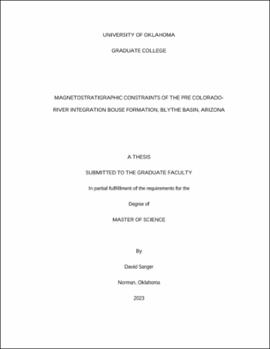| dc.description.abstract | Magnetostratigraphic studies offer unique insights into the orientation of Earth’s ancient magnetic field and provide an opportunity to determine the chronology of depositional events, particularly when combined with other dating methods. A successive series of basins trending south from Needles, California to Cibola, Arizona, records the evolution of the lower Colorado River through the preservation of sediments within the Bouse Formation. The Bouse Formation is characterized by basal marl, tufa, alternating silts and muds and Colorado River sands. It was deposited between ~5.24 and ~4.6Mya and represents pre-Colorado River integration deposits. Magnetic polarities are recorded in sediments during deposition and are revealed through the stepwise, destructive process known as alternating field (AF) demagnetization. The magneto-stratigraphic record near the end of the deposition of the Bouse Formation is poorly constrained trained and can be improved through the identification of a transition between the normal polarity Sidjufall (4.81-4.89Mya) and Nunivak (4.49-4.63Mya) subchrons. This study is anchored by dates acquired through tephrachronology of 40Ar/39Ar in detrital sanidine grains in the middle of the Sidjufall and Thvera subchrons. Sanidine grain analysis within Hart Mine Wash revealed an age of ~4.72Mya, corresponding to the age of the Lawlor Tuff, within the Bouse formation. Additional tephrachronology of the Bouse Formation revealed an age of 5.24Mya for the Wolverine Creek Tuff, just below the base of the Bouse Formation in the Lost Cabin Beds in Cottonwood Valley. The magnetic inclinations of the samples were anchored by the absolute ash dates and compared to the geomagnetic polarity timescale (GPTS) to determine the timing of deposition of the Bouse, and therefore the timing of arrival of the Colorado River to Blythe Basin. Surrounding the Hart Mine Wash ash lie sections of both normal and reversed polarity. Additional normal polarity intervals were captured in sediments surrounding Parker, AZ (Riversides) and further North near Lake Havasu City, within Mohave Valley (See Figure 2). The study consists of 3 unique locations, 26 individual sites, 40 sediment core specimens and 76 oriented specimens. Rock magnetic tests include hysteresis, first-order reversal curve (FORC) diagrams and Curie temperature analysis of thermomagnetic curves. These tests yielded low-quality results due to a low abundance of magnetic minerals, although the presence of stable ancient magnetization in specimens has been established through AF demagnetization. The results of this magnetostratigraphic study will improve the understanding of the timing of deposition of the Bouse Formation and date the arrival of the Colorado River within Blythe Basin to ~4.6-4.7Mya. | en_US |
